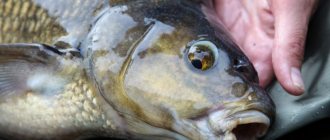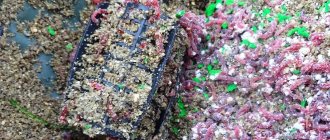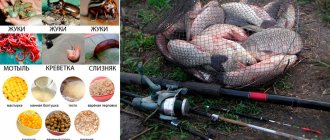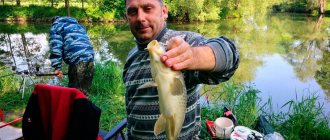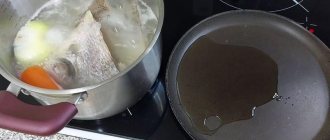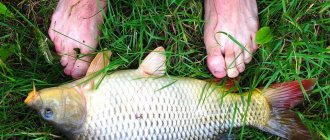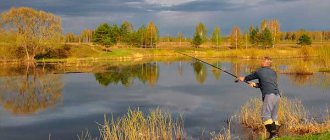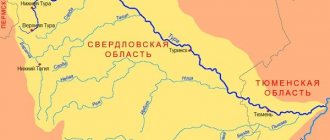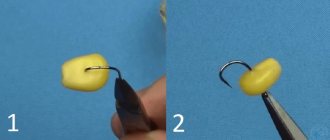Corn is one of the best, most effective and affordable baits for carp fishing. If you don’t want to cook the bait yourself, you can easily buy it in canned form at any grocery store; it is also suitable for fishing, holds the hook well and has an attractive aroma for fish. Corn is clearly visible even in muddy water, fines are completely cut off and this is not all the advantages of this attachment.
If you fish with canned corn, it is best to take the Bonduelle variety. It is larger and, according to some observations, more attractive to fish.
When to catch carp on corn
Corn is an excellent bait for catching carp, but it does not work all year round. It will be an excellent bait only in the summer, late spring and early autumn. In general, this bait only works in warm water. When water temperatures are low, carp should be caught using bait of animal origin.
In the hot season, carp responds well to bait of plant origin and it happily eats in huge quantities the plant bait it likes that comes across its path. Corn is one of those baits that he is unlikely to ignore. It looks very appetizing for fish.
Tactics for catching carp on corn
Catching carp with corn requires a generous amount of bait. You must create a feeding table out of groundbait and put your bait there too. The fish comes to the aroma and lingers on the feeding table for quite a long time. The feeding table should be replenished periodically so that the fish do not leave the feeding point.
When fishing with corn, the same corn can serve as bait. For bait, you can use smaller grains or overcooked ones, which are not suitable for hooking. Also, it can be added to any bait mixtures. Whatever bait you use, corn should be a mandatory part of the bait, since in our case it is the bait.
But first you need to determine a promising place to feed. And you should catch carp near snags, in areas of the reservoir with uneven bottoms, near holes, on edges and dumps. Carp also go into shallow waters in search of food, then they should be caught near thickets of reeds or reeds.
Depending on the weather, carp can occupy certain points of the reservoir, so on hot days you should look for it in holes, in thickets of coastal vegetation or under the crowns of trees hanging over the water. On cool but clear days, carp will, on the contrary, tend to shallow water and areas that are well warmed up by the sun.
Catching carp on corn is very effective using a float rod. Fishing takes place at a relatively short distance from the shore; it is very easy and convenient to feed the fishing point, attracting fish to it. But trophies are caught extremely rarely on a float rod.
It is very convenient to use carp rods or a feeder with long casting to get carp from their favorite places - all kinds of holes or shelters far from the shore. And if the reservoir is small, then you can successfully present the bait exactly to the opposite bank. And as you know, the bite is always better on the other side. Well, seriously, this tactic is good when there is no approach to the opposite bank and the only way to fish there is long casting. Fishing with carp gear with long casting often brings trophy specimens into the catch.
It is more difficult to feed fish when long-casting, but here a boat, a bait rocket, a boat or a slingshot come to the aid of the fisherman. Feeding with a rocket or slingshot will not work so precisely, but you can create a good feeding table for carp in any case and the fish will always spin next to your bait. And with the help of a boat you can bring both bait and tackle to the desired point.
The optimal time of day for fishing is from sunset to 11 am. During the day, carp bite extremely rarely. Usually, its fishing takes place overnight, then it is possible to catch all the most promising hours - sunset, dawn and the night itself. It is worth noting that in each body of water this fish behaves differently and is most active at different times.
There are reservoirs where carp bite exclusively in the morning, and others where they fish well for several hours at night, for example from 01:00 to 03:00. And there are reservoirs where you can’t catch it at all at night, although on others it’s quite successfully and consistently caught right at this time. Each body of water needs to be studied in order to adapt as much as possible to the behavior of the fish.
You should also know that carp is a very weather-dependent fish. When there is a sudden change in weather or changes in pressure, its activity decreases very noticeably, it becomes very difficult to catch it and, often, only professionals succeed in this in such weather, and then in much smaller quantities than in weather favorable for fishing.
Specifics of catching roach on corn
Catching roach with corn involves using smaller grains that are sufficiently boiled. It is important to correctly attach a single bait, you can read above how to attach corn to a hook. Fishing is more successful in the warm season. To fish for roach, you need to choose the right fishing rod: it should be light and short, from 2.5 to 3.5 meters.
Roach is not picky about the environment, so it can be found both in standing reservoirs and in reservoirs with strong currents.
Corn fishing equipment
To catch carp using corn, you can use several equipment options. One of them is placing grains directly on the hook, the second is using hair equipment, with this method the hook remains bare.
Using hair equipment is definitely better and more effective. When a carp bites, it sucks in the bait along with the bare hook; often you don’t even need to hook it; with this installation, the fish hooks itself quite reliably. But, nevertheless, it is better to do a control sweep.
When fishing with conventional equipment without hair, when the grains are dressed directly on the hook, the probability of idle bites is higher. The corn itself can prevent the fish from getting a good hook, or the carp can prick itself and spit out the bait. There is a separate article on the methods of planting corn on the website ryba4ok.ru, you can read it.
You can make the hair rig yourself - it’s quite easy to do, but in fishing stores it will cost a penny, so I think there’s no point in wasting time on making it.
Features of bait
When fishing with corn, as with other baits, the use of bait is necessary. To do this, the cooked grains are divided into two parts.
The first part consists of large grains; they will be used as bait. The second part, much larger in volume - grains that are small and unsuitable for hooking, will form the basis of the bait.
Corn grains intended for bait can be mixed with soil and breadcrumbs. The first component adds heaviness to the mixture, quickly sinking it to the bottom at the desired point in the reservoir, the second “dusts”, attracting the attention of crucian carp.
In addition to the base, boiled or canned corn is often used in bait as an additional component.
How to cook your own corn
Canned corn has one significant drawback - the can may contain a low-quality product or simply not suitable for fishing. The grains may be too small, crushed or overcooked. Of course, if you have found a certain brand that meets all the requirements for fishing, then there is no question.
But most fishermen still prefer to prepare corn for carp fishing themselves. And you can prepare it in two ways - boiling and fermentation.
Cooking
Before boiling corn, it must be soaked in water for at least one day. If possible, you can soak it longer - 2-3 days. As a result of soaking, it softens and swells, now it can be easily cooked.
Cook for about 30-60 minutes. Readiness is determined by its softness. It is necessary to achieve a state of corn where it does not fall apart, and, at the same time, becomes quite soft. Just try squeezing the grain with your fingers; it should crush with moderate force but withstand light compression.
Fermentation
Fermentation is the fermentation of a product due to the enzymes contained in it. That is, we need to achieve fermentation of corn. Carp bite on fermented corn with particular enthusiasm, since they are very attracted to the aroma and taste of such bait. It certainly has an advantage over its boiled and canned counterpart, but not all fishermen know about this method of preparation. The site ryba4ok.ru will share this secret with you.
Fermentation begins with cooking. It is necessary to lightly boil the corn until half cooked. The grains are still quite hard, but they can already be placed on the hook. In addition, they will soften further during fermentation. Corn for fermentation should be cooked a little less than when cooking it normally.
Then it is poured into a fermentation container - this can be a saucepan or bucket. There may still be water in the corn after cooking, but if there is not enough water, you will need to add more. Water should cover the corn by 3-5 cm.
For half a bucket of corn you need to add 200 grams of sugar, 20 grams of active yeast and honey - 2-3 tablespoons. Honey will give it an additional aroma, and sugar and yeast will promote faster fermentation, since the bacteria through which this process occurs require these components for their vital activity.
The next thing we need to do is cut off the access of oxygen to our future bait. To do this, you need to add vegetable oil to it. Carefully pour the oil into the container with the corn so that it creates a protective top layer that will not let air through. We leave this process for a few days, after which we can go fishing and use corn as the main bait - the carp will not resist.
Corn fermentation: video
What kind of corn is used to catch crucian carp?
Bonduelle
Many anglers use canned corn , sold in grocery stores. You don’t have to buy the most expensive one – fish don’t look at the price tag. However, it is important to choose a moderately strong one, with large grains and clear brine.
- Too soft, falling apart when you try to put it on a hook, suitable only for bait.
- Small grains attract only small fish - it is also better to leave them for complementary feeding.
- A cloudy brine indicates that the preparation technology has been violated and the product is most likely spoiled.
The advantage of this type of bait is its availability. It can be purchased at any time of the year, it does not require preliminary preparation, you can go fishing impromptu - just stop by the store along the way.
Experienced fishermen prefer fresh or dried corn and cook it themselves. To do this, take cobs (in season) or already hulled grains (they are sold as poultry feed).
- Milky ripe grains can be used without cooking, immediately placed on a hook.
- Dried corn is pre-soaked and then boiled until desired softness.
Salt and sugar added to the cooking water help the corn to develop its odor, which is attractive to fish. Flavorings will further increase the catchability of bait. For example, the decoction can be seasoned with vanillin, coriander, cumin, and cinnamon. By experimentation, you can select those additives that will give the best effect on the body of water where you fish.
Specialized stores also offer artificial corn for catching crucian carp. A successful silicone grain imitation can be used with or without flavoring. A significant advantage of the dummy is its reusability. In addition, there is no chance that the fish will rip the bait off the hook and walk away, leaving you with nothing.
Tricks for catching carp on corn
You all know that carp fishing involves a long wait for a bite. You just sit and wait for the fish to bite, peering into the float or listening to the alarm. This fish is very smart and careful, so sometimes you have to wait for hours, or even days, for its bite.
Catching carp with corn, although it has its unconditional advantages - this bait is clearly visible, it smells good... But carp can simply swim past it for a very long time and only after 5-10 approaches decide to try it. But if you use it in a sandwich with other bait, then the carp simply will not be able to swim past such an attractive bait.
Corn goes very well with a worm or maggot - these are the best sandwiches that work on carp just like a charm. First you need to thread corn - one or several grains - onto the hook, and complete the composition by baiting a dung worm or several maggots onto the hook's sting.
These are the tips, recommendations and knowledge the website ryba4ok.ru told you. If you liked or did not like the article, rate the post below, if you have something useful to add, leave comments, we will be sure to add important information to the article. Good luck to everyone and no tail, no scales.
ryba4ok.ru
Product advantages
Corn is included in the group of vegetable attachments. The grains have distinct benefits:
- fish like the aroma, taste and color;
- constant availability of bait on store shelves;
- reliable fastening on the hook;
- grains do not dissolve in water;
- the degree of softness and hardness during cooking varies;
- It is allowed to mix flavors with grains (this improves the quality of feeding fish);
- comparatively cheap.
The attractiveness of corn to fish is explained by its chemical composition. This cereal crop is low in protein and high in carbohydrates, among which starch predominates. Fat in grains is represented by valuable unsaturated acids (total amount - no more than 5%). Corn contains a high percentage of phosphorus and is rich in carotene and vitamin E.
What fish is it suitable for?
Before boiling corn for bait, you need to find out what types of fish live in the selected body of water. To ensure a good bite, it is important to take into account the taste preferences of specific species, since not all fish are attracted to grains. The main fan is the “glutton” of the reservoir – carp. When fishing for it, corn can be used as bait or groundbait.
Among the lovers of corn grains are such fish as:
- crucian carp;
- roach;
- ram;
- rudd
How to cook?
To prepare bait, use raw or canned corn . When buying grains in a jar, you must choose only high-quality products, since damage to the integrity will not allow the grains to strengthen on the hook, and the small size will attract insatiable small things.
We will tell you in more detail how to prepare bait for fish (including carp) from corn.
From sweet corn
This is ready-made corn from cans, its special feature is the inscription “sweet” on the label. The advantage of this bait is the absence of labor-intensive processing before use. The jar should be opened and the grains should be placed on the tackle. For fastening, the “hair-mounting” method is most often used.
How to make your own sweet corn:
- Soak grains from a ripe yellow cob in water. We stand for 1 to 3 days.
- Pour water over the swollen corn, place on low heat and boil for 30-60 minutes. After the water has boiled, add sugar or honey.
- Remove from heat, drain the water, add vanilla to the beans.
- Let the bait sit for 24 hours. During this period, lactic acid will evaporate from the corn and a characteristic odor will appear.
Steaming the grains
The cooking process involves soaking the grains in warm water for 24 hours. During this period, be sure to change the water 2-4 times. Next, a thermos will come in handy. It needs to be filled a quarter full with grains, then add flavoring or spices (of your choice). Fill the rest of the volume with boiling water and close the thermos tightly. The corn will be ready in 4 hours.
From fermented sour
The total preparation time for such bait takes up to 4 days. It is necessary to prepare corn for biting in advance. The correct fermentation algorithm includes the following steps:
- Pour warm water over the grains and boil for 30-40 minutes. Drain the water.
- Pour boiled corn with new cold water, add 1 tbsp. sugar per 1 liter of water, dry yeast (10 g of yeast per 1 kg of corn). Honey can be used as a flavoring additive.
- Mix the resulting mixture and place in a glass container.
- Pour sunflower oil on top - the product will prevent air penetration.
Fermentation occurs when yeast bacteria absorb sugar and release alcohol and acid. It is prohibited to close the container at this time due to the abundant release of carbon dioxide. Fermentation is necessary to break down the tough outer skin of the beans. As a result, the bait will become soft, and nutrients will actively flow into the water.
You can also watch the video to learn the recipe for making fermented corn:
Inedible imitators
These are inedible corn kernel simulants. Synthetic plastic is used to make them. In appearance, such corn resembles a small container with chemicals that attract fish and activate the bite. Among the advantages of the bait are the possibility of reusable use and quick effect .
The group of artificial baits includes products. Such grains are an alternative to reusable baits. Their peculiarity is that they decompose in a body of water. Made from soft materials, available in a liquid package.
Fishing gear
To decide on one or another fishing method, you need to understand how complex the process itself is: if the fishing object is easily accessible, then it is enough to use 1-2 options. Considering the caution of the chub, it is not so easy to lure it into your nets, so the angler has to constantly experiment with gear and bait.
Among the effective methods of fishing for chub are:
- Hunting using bait , in particular grasshopper, dragonfly, butterfly. Also, good results are obtained with worms, bloodworms, dough, May beetles, and bread. As a fishing tool, a float or fly fishing rod with a length of 4–6 m is used.
- Spinning tackle using spinners , in particular spinners equipped with a petal, show excellent results in fast currents.
- Bottom tackle , it is chosen for catching prey in rivers with fast or medium flow.
- Float fishing rod , where cherries, chicken giblets, and cheese serve as bait. It is better to fish in reservoirs with moderate currents.
Gear requirements:
- Spinning. This is one of the most catchy gear for chub, you can buy it at an affordable price, and you can learn how to use it on your first fishing trip. Here it is important to follow the rules of camouflage, otherwise the maple, also called the chub, may immediately hide near the shores of the reservoir and not react in any way to the offered bait. In such a situation, it is advisable to go hunting on a boat.
- Components of the spinning tackle: short fishing tool with a length of 2.1 - 2.4 m with a test load of 5 - 10 g; inertia-free reel 1500 – 2000; monofilament or braid with a breaking load of 4 - 5 kg.
- Spinning rods work well in water areas with strong currents; they are equipped with oscillating spinners, miniwobblers, and microjigs.
With this method of fishing, the working depth should be up to 1.5 m. Hooking is done smoothly, without sudden movements, you should not be afraid of the prey disappearing, this happens extremely rarely. The main thing is not to miss the moment and quickly raise the fish’s head above the water, so it will instantly grab the air and calm down, and the spinning rod will remain safe and sound.
Surface fishing rod
The tackle allows you to catch chub using aerial insects (chafer, dragonfly, etc.).
Tackle components: elastic rod with a length of up to 5 m with high-quality guides; both popular models of inertia-free products and modern inertial reels with an easily rotating drum can be used as a reel. As the main fishing line, a monofilament thread with a cross-section of 0.25 mm is well suited; for a leash with a length of 1 m, a fishing line with a diameter of 0.20 mm is used.
The hook number depends on the chosen bait; most often they use items No. 8 – 12.
The bait, in particular the cockchafer, is hooked onto the abdomen; in this form, the bait is still able to move, which attracts fish.
To cast light equipment, it is recommended to use a water-filled float made of colorless material. The fished object takes such a float for an air bubble and boldly attacks the bait. This is a good bite alarm; it can be seen even on waves from a distance of 50 m.
Fishing with this type of gear is ideal for beginner anglers.
Feeder or picker tackle
equipment for catching chub in winter on a feeder
The choice of bottom tackle is determined by the seasonal (autumn) behavior of the fished object; maple prefers to stick to deep edges.
Tackle components: high-quality fishing rod with a length of 3.3 – 3.9 m; sensitive tip with maximum flexibility; inertia-free reel model with a 2000 spool. For the main line, it is recommended to use a fishing thread with a cross-section of 0.22 - 0.25 mm, which is equipped with a sliding sinker with a weight of 6 - 10 g. For the leash, use the same thread as for the float tackle.
A distinctive feature of picker gear from a feeder is the size of the rod: the picker has a length of up to 3 m, and the feeder has a length of over 3 m.
The hook plays a special role here; it must be as sharp as possible, given that the hunt is carried out in a reservoir with a rocky bottom. The type of hook also depends on the type of bait: a thin product is suitable for bait of animal origin, a more massive type is suitable for vegetable bait. For chub hunting, it is recommended to use a circle hook.
Donka
donkey rig for chub
This type of tackle is suitable for fishing from the bottom of a reservoir where there is a fast current. If you use bottom tackle on quiet rivers, the line will sag. The bottom tackle does not have a float, so casting a fishing line over a long distance is quite possible and convenient, so the fisherman manages to comply with the rules of camouflage.
Donka works especially well in the summer, when it is at its peak of activity.
Winter fishing rod with jig or float
During this period, fry, bloodworms, worms, raw liver, chicken offal, and caddis are used as bait during this period. Jigs made of silver-plated lead in the form of an elongated drop with a hook No. 5 - 6 are considered catchable. It is recommended to keep the bait near the bottom, periodically raising it to a height of up to 50 cm. The fishing line is used with a diameter of up to 0.2 mm.
The fishing rod is equipped with a sensitive tip and reel. When capturing the bait, the nod bends sharply. The hook should be confident, but not too strong. It is better to catch trophy specimens using a hook.
Nuances
This is canned corn, which is prepared according to a special recipe to improve the bite. You can purchase such a product at any specialty store. Fishing corn is produced in cans; the grains are the same size, but vary in color saturation and smell.
Producers are also concerned about maintaining the integrity of the corn . The product contains various additives to increase the shelf life of the grains.
What brands do fish like?
Residents of water bodies show increased interest in well-known and proven brands. These are "Bonduelle" and "Vernet". Experienced fishermen advise buying brand products not in cans, but in glass containers (the best grains are packed here).
Among artificial bait manufacturers, Enterprise Tackle stands out. The developers promise that the baits retain their quality even after 6 hours in the water.
Of the companies producing fishing corn, the following deserve attention:
- "Sensas".
- "Dynamite Baits."
- Bait Tech.
What kind of fish can you catch with corn?
It’s not for nothing that many fishermen prefer corn bait. Almost all peaceful fish in water bodies are caught for this mouth-watering delicacy. Most often found on a hook with such bait are: crucian carp, chub, carp, roach, tench, bream and carp. Even some predatory inhabitants of the underwater world cannot resist a tasty piece of aromatic grains. Why is it popular among fishermen:
- Sits perfectly on the hook, the point of the hook is almost invisible.
- Bright color and smell.
- Affordable price.
- Possibility to cook yourself.
- The grains are used for various types of fishing.
Advice! If you prefer canned corn, don't skimp on your purchase. Cheap corn may be soft and overgrown.
Photo 1. Whole grain corn is a semi-finished product for bait.
If you decide to fish for carp
The bait is successfully used for catching carp using a float rod, feeder tackle and various types of donks. Carp loves yellow, overripe corn of late varieties. You can buy cobs or raw threshed grains at the farmers market.
At the first stage, you need to pour the corn into an iron container, fill it completely with water and leave for 1-3 days. This is the time for the grains to swell. Fermentation also occurs in the first 24 hours.
Signs of fermentation are fermentation and water turning yellowish, with a characteristic odor . During the fermentation process, the top skin disintegrates, the enzymes from the grains soften and flow better into the water - the corn becomes more attractive to carp.
What actions to take next?
- The water in which the grains were infused must be drained.
- Fill the corn with fresh water and boil over heat for 60 minutes.
- Add flavorings - sugar, honey. Sweetened grains will attract carp better than “unleavened” grains.
Attaching bait to a hook
Baiting corn grains is a responsible process on which the overall success of fishing depends . It is allowed to plant from 1 to several corn, depending on weather conditions, the depth of the reservoir, and the quality of the bite.
To catch carp, it is advisable to use a large hook, on which 8-10 corn are attached. When fishing for bream, it is recommended to combine corn and worms (maggots). If fishing takes place on a muddy bottom, you need to take artificial corn.
Variety of corn grain fixing:
- Plant 1 grain. Small or medium sized hooks (numbers 16 to 20) are suitable. You can insert it by making a puncture across or through the side to the middle. You can also pierce the edges of the grain. The specific method is selected depending on the size and hardness of the grain.
- Features of the attachment of several corns. You need to plant it not in the center, but on top of the grain.
- Hair installation technique. You need to attach a thin thread or fishing line (called hair) to the hook. You should tie a loop at the end. Pierce the grains with a needle or a long drill. We insert a fishing line into the hole in the corn and secure it with a special stopper. If you don’t have one, you can take a match or a straw.
To build a bait from maggots and corn, you need to put 2-3 larvae on the hook, then 1 grain, then 1 or 2 more larvae. When creating a “sandwich” from corn and a worm, you need to put 1-2 large earthworms on the hook, and 1-2 grains on top. If the worm moves in the water, the chances of attracting fish will increase.
There are several ways to prepare corn for fishing. This is the preparation of sweet bait, steaming or fermentation. Also, to improve the bite, experienced fishermen advise adding flavorings, and when attaching bait, making “sandwiches” from corn and a worm.
selo.guru
Features of catching carp on corn
Catching carp is a very interesting activity. To achieve the maximum catch, you need to choose the right gear to catch it. Carp is hunted for its fragrant smells and attractive appearance. Large grains will attract fish and scare away small inhabitants of the reservoir. To prevent the pecking carp from leaving the hook, it is necessary to use a heavily boiled soft bait. When the bait is in the water for a long time, it is periodically necessary to change it to fresh grain, otherwise it will lose its aromatic odors and become indifferent to the fish.
For fishing for carp, you can use canned corn from a supermarket or fishing store, as it has a more expressive smell.
To catch carp using corn, it is necessary to correctly install the gear. To avoid spooking the fish with a metal hook, it is best to use a hair rig.
Which corn to choose as a bait for fishing?
If we talk about corn beans, then there are the following options: self-cooked grains, canned and young milk grains. Let's look at each type in more detail.
Homemade boiled corn.
Despite the fact that regular stores and specialized fishing shops have a wide selection of ready-made corn, many fishermen continue to cook, soak and steam these grains themselves. And this of course makes sense.
Firstly, there is a category of fishermen who like to completely control the process of preparing bait and bait, and prepare for fishing long before the actual fishing.
Secondly, many are not satisfied with the quality of canned beans, which are often cut, crushed, small or overcooked. And when cooking it yourself, you can give the grains the necessary hardness (softness) and add your most effective concentrator or dye. In addition, before cooking, you can select large grains for bait, and leave small ones for bait.
Well, thirdly, when using corn to feed carp, for example, you have to use not such a small amount of it. And if the feeding of the fishing spot lasts for more than one day, then a bucket of boiled corn can go away calmly.
There are many cooking recipes. But the general principle is that the grains must be soaked before cooking. Such fermentation can take from one to three days. Moreover, you can soak it in plain water or, for example, in hemp starter.
After the grains swell, the cooking process follows. To do this, it is better to use an enameled or stainless steel container. The water in which the corn is boiled can be pre-sweetened with sugar or honey. The cooking process lasts from 30 minutes to an hour. Our corn should be quite soft, but not overcooked. After this, we leave it in the water for another 1-2 days.
At this stage, you can add flavorings to the water. During this time, the grains will acquire the necessary aroma and become more attractive to fish.
In the selection of fragrances, it is difficult to advise anything specifically. Local fish tastes and the time of year also play a role here. The most popular are the smells of vanilla, honey, banana and adding a sweetish taste to the nozzle.
Few fishermen know that carp cannot crush grains with their internal teeth. And his intestines are not able to digest the tough skin of cereals. There are even cases where when a carp ate raw grains that were not completely swollen, it died from intestinal rupture. It was precisely because the nozzle “reached” already in his stomach and, swelling, led to rupture.
The process of infusion of corn grains brings them to full readiness. The lactic acid that begins to form in such a sweet solution softens the corn. And it has been noted more than once that such a sour, unpleasant odor for the fisherman is even liked by the fish. Many people deliberately bring the grains to “sour” because they are sure that this is the taste that will attract fish more. But the main thing here is not to overdo it and rely more on your experience and instinct.
If you cook the grains for a long time, this will lead to them boiling and turning into porridge. This type of porridge can be used to add to bait. If you have welded too much bait and the infusion process has come to an end, then you can freeze the grains for storage until your next fishing trip.
Cooking methods
There are quite a lot of ways to cook corn at home, but, in principle, they all boil down to the fact that the grains must first be soaked for several days. This fermentation will give the corn a slightly sour taste and aroma that freshwater fish like so much.
When the grains swell, you can start cooking them. It is best to do this in a large enamel pan. You need to add a few teaspoons of sugar or honey to the cooking water. Depending on whether you soaked young or old corn, you will have to cook it for 30–50 minutes. The grains should not be completely boiled, but they should become soft. Once the cooking process is complete, the corn should be left in the water for approximately 24 to 36 hours. At this stage, you can add various flavors to the water that bream like: strawberry, vanilla, banana, garlic.
Is it necessary for the hook point to stick out from the bait or bait?
Let's touch on a little about the method of attaching corn to a hair or hook.
So should we hide the hook tip or not? This is often asked by fishermen who are mastering feeder fishing. For them we will answer: no, it is not necessary. The corn skin is quite dense and for better hooking of fish it is good to leave the tip of the hook bare. And you don’t have to be afraid that the fish will prick itself on the hook’s tip and leave. Numerous experiences of fishermen have boiled down to the fact that the sting is brought out almost when using any attachments and baits.
When fishing, the number and size of grains on the hook depends on the size of the hook itself and, accordingly, the size of the intended fish.
For example, when fishing for carp on a feeder, up to 5-8 grains of bait can fit on a hook with numbers from No. 4 to No. 8. Moreover, it is better to use different grains, both large and small, and they must also be planted unevenly, threading through the center or edge of the grain. Such a bait will look more natural and will not arouse suspicion in the fish.
When catching smaller fish, the hook size decreases and, accordingly, the number of grains decreases. For example, when fishing for crucian carp, two grains of corn are planted , which can also be supported with boiled pearl barley. This will hold the bait longer, since crucian carp likes to savor the grains for a long time, sucking them.
When fishing for roach or silver bream with a feeder, one grain is generally placed on the hook. Moreover, the exposed point of the hook can be made larger. Such a fish, with its sharp bites, often gets caught in the lower part of the oral cavity.
A sandwich also gives an excellent effect - a combination of corn with a worm or maggot.
If after cooking the grains are not soft enough and it is difficult to thread them with a crochet hook, then hair installation can help. Corn on a hair for our reservoirs may turn out to be more productive than even fishing with boilies. A needle for piercing boilies can easily cope with corn grains.
feederist.ru
Crucian carp, the younger brother of carp, gives us a lot of positive emotions when fishing on a ton of gear. It is clear that crucian carp is not the largest fish in our waters. Meanwhile, this small fighter with reddish pectoral and ventral fins is not so easy to outwit. Therefore, from time to time, fishermen organize a “crucian carp day”.
The bites of crucian carp are very careful, almost like those of tench. The float moves slightly to the side and sinks several times, as if not daring to go under water. You shouldn’t be too hasty with hooking; the crucian carp will still be hooked on the upper lip. It is best to catch crucian carp with thin tackle: a match rod from 3.9 m, a small reel with a high gear ratio, a main line with a diameter of 0.16 mm with a leader of 0.14 mm, sensitive English waggler floats, thin wire hooks No. 14-16 .
Over many years of fishing, many anglers have come to the conclusion that the best bait for crucian carp is corn. In this case, one single corn grain is placed on the hook. When fishing with corn, other fish do not bite as often as when fishing with maggots. In addition, it holds perfectly on the hook and is clearly visible in muddy water, which crucians love so much. It is also suitable for feeding the fishing spot.
First feeding
Corn is mixed with the main bait, which is flavored with a pinch of caramel powder. Most of the bait is thrown in before fishing begins, so as not to disturb the fish during it with the sound of bait balls falling into the water. When the bites become regular, I throw a handful of clean corn onto the feeding area. To notice cautious bites, you need to load the float correctly. The main load is located directly under the keel. A leash 30 cm long remains unloaded; above it, on the next meter of fishing line, several small pellets (No. 8 = 0.06 g or No. 6 = 0.1 2 g) are attached, ensuring that only l cm of the antenna peeks out of the water.
A long leash often gets choked. To avoid this, you should cast the rig with a good swing, and before it falls on the water, slightly slow down the line with your index finger on the side of the spool. The amount of descent is adjusted so that the nozzle is located 5 cm from the bottom. This makes it easier for the fish to approach the bait, and for the fisherman to notice the bite. As when fishing for tench, hooking should not be early, because crucian carp often “court” the bait for a very long time, and time must pass before it ends up in the fish’s mouth.
Nozzle movements
During the period of no biting, it often happens that fish only lightly touch the bait and twitch it at intervals of half a minute. If the crucian carp no longer bites, then you should feed less often. Otherwise, you can achieve the opposite result - “feed” him. When the bite resumes, those who want to catch a lot of fish must move the hooked crucian carp away from the school as quickly as possible, which will not be difficult with a reliable line and a high match rod.
It is important to choose the right fishing time. In contrast to tench, which bite even in the late evening, crucian carp bites mainly in the morning. You need to be at the reservoir before dawn, then by noon you will have your catch.
www.ribalka.su
Hooking corn
Now let's look at the methods of hooking corn. The number and size of grains is determined based on the size of the hook and the expected size of the crucian carp.
Planting one grain
This method is often used to fish with a small hook when you plan to catch small crucian carp, for example, with an ear. Each fisherman has his own rigging option:
- over the edge;
- through the side;
- in the center, across the grain.
When planting over the edge or side of the grain, the end of the hook is not hidden. This baiting option is used when fishing for small fish. By threading the corn through the center, the point of the hook on the reverse side is masked at the bottom of the grain. This hook attachment option is used when you plan to catch larger crucian carp. Some prop up the corn with steamed pearl barley. This holds the bait more tightly when the crucian carp sucks on it for a very long time.
You can put corn on a hook in different ways, depending on what size crucian carp you want to catch
Planting multiple grains
Used when you plan to catch large fish with a large hook. The options for packing grains are exactly the same as in the method described above. The most effective option is in the center, across the grain. Then it is difficult for a small fish to tear off the bait, and a large fish tries to capture it entirely and at the same time clings tightly to the hook.
Catching fish on a hook No. 4-8 allows you to attach 5-8 corn. It is better to take grains of unequal sizes and put them on unevenly, piercing them in the center or over the edge. This way the bait will look more natural and will not arouse any suspicion among the crucian carp.
What kind of fish bites on corn?
Here is a short list of cases when you can and should take corn with you:
It is clear that almost any non-predatory fish can bite on plant bait, and you can safely count on a wider range of fish species in the cage.
The lover of this bait, the so-called “glutton”, is carp. He will not pass by the juicy grain of corn. When fishing for carp, it is used as both bait and groundbait. Because corn is a classic carp bait. Most of the winners in carp competitions used corn in various variations.
Corn as a nozzle
Three types of corn are used as bait:
- Canned;
- Homemade;
- Artificial.
Combining any corn with a piece of floating foam makes it a pop-up bait. The artificial corn is flavored and the homemade kernels are fermented and sweetened.
Canned corn
Canned corn is often used as bait. It is soft, bright, fragrant and ready to use. However, when fishing for carp, such a bait is often attacked by other fish, which causes some inconvenience. In addition, when attaching corn to a hair rig, it is more convenient to use homemade grains.
Homemade corn
Corn for home-made fishing is much cheaper, so it is also used as bait. This does not mean that “raw” corn is in any way inferior to canned corn; it all depends on the method of preparation.
